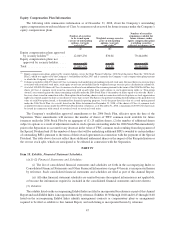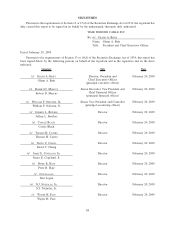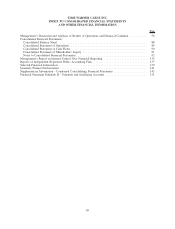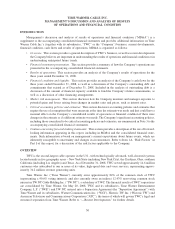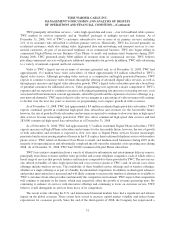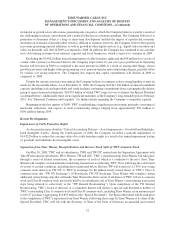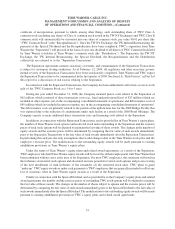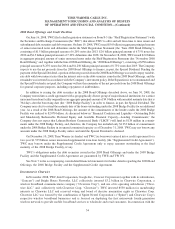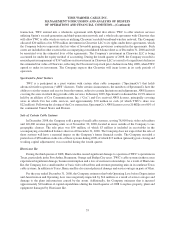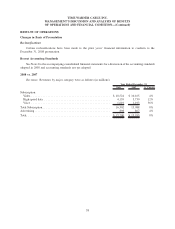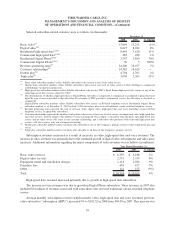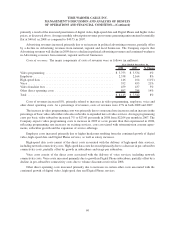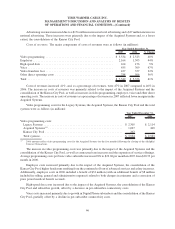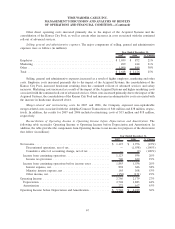Time Warner Cable 2008 Annual Report Download - page 67
Download and view the complete annual report
Please find page 67 of the 2008 Time Warner Cable annual report below. You can navigate through the pages in the report by either clicking on the pages listed below, or by using the keyword search tool below to find specific information within the annual report.marketing expenses, billing system charges, non-plant repair and maintenance costs, fees paid to Time Warner for
reimbursement of certain administrative support functions and other administrative overhead costs. Additionally,
management fees received from TKCCP prior to August 1, 2006 were recorded as a reduction of selling, general and
administrative expenses.
Use of Operating Income (Loss) before Depreciation and Amortization and Free Cash Flow
Operating Income (Loss) before Depreciation and Amortization is a financial measure not calculated and presented
in accordance with U.S. generally accepted accounting principles (“GAAP”). The Company defines Operating Income
(Loss) before Depreciation and Amortization as Operating Income (Loss) before depreciation of tangible assets and
amortization of intangible assets. Management utilizes Operating Income (Loss) before Depreciation and Amortization,
among other measures, in evaluating the performance of the Company’s business because Operating Income (Loss)
before Depreciation and Amortization eliminates the uneven effect across its business of considerable amounts of
depreciation of tangible assets and amortization of intangible assets recognized in business combinations. Additionally,
management utilizes Operating Income (Loss) before Depreciation and Amortization because it believes this measure
provides valuable insight into the underlying performance of the Company’s individual cable systems by removing the
effects of items that are not within the control of local personnel charged with managing these systems such as income tax
benefit (provision), other income (expense), net, minority interest income (expense), net, and interest expense, net. In this
regard, Operating Income (Loss) before Depreciation and Amortization is a significant measure used in the Company’s
annual incentive compensation programs. Operating Income (Loss) before Depreciation and Amortization also is a
metric used by the Company’s parent, Time Warner, to evaluate the Company’s performance and is an important measure
in the Time Warner reportable segment disclosures. A limitation of this measure, however, is that it does not reflect the
periodic costs of certain capitalized tangible and intangible assets used in generating revenues in the Company’s
business. To compensate for this limitation, management evaluates the investments in such tangible and intangible assets
through other financial measures, such as capital expenditure budget variances, investment spending levels and return on
capital analyses. Another limitation of this measure is that it does not reflect the significant costs borne by the Company
for income taxes, debt servicing costs, the share of Operating Income (Loss) before Depreciation and Amortization
related to the minority ownership, the results of the Company’s equity investments or other non-operational income or
expense. Management compensates for this limitation through other financial measures such as a review of net income
(loss) and earnings (loss) per share.
Free Cash Flow is a non-GAAP financial measure. The Company defines Free Cash Flow as cash provided by
operating activities (as defined under GAAP) plus excess tax benefits from the exercise of stock options, less cash
provided by (used by) discontinued operations, capital expenditures, partnership distributions and principal payments
on capital leases. Management uses Free Cash Flow to evaluate the Company’s business. The Company believes this
measure is an important indicator of its liquidity, including its ability to reduce net debt and make strategic
investments, because it reflects the Company’s operating cash flow after considering the significant capital expen-
ditures required to operate its business. A limitation of this measure, however, is that it does not reflect payments made
in connection with investments and acquisitions, which reduce liquidity. To compensate for this limitation, man-
agement evaluates such expenditures through other financial measures such as return on investment analyses.
Both Operating Income (Loss) before Depreciation and Amortization and Free Cash Flow should be
considered in addition to, not as a substitute for, the Company’s Operating Income (Loss), net income (loss)
and various cash flow measures (e.g., cash provided by operating activities), as well as other measures of financial
performance and liquidity reported in accordance with GAAP, and may not be comparable to similarly titled
measures used by other companies. A reconciliation of Operating Income (Loss) before Depreciation and
Amortization to Operating Income (Loss) is presented under “Results of Operations.” A reconciliation of Free
Cash Flow to cash provided by operating activities is presented under “Financial Condition and Liquidity.”
57
TIME WARNER CABLE INC.
MANAGEMENT’S DISCUSSION AND ANALYSIS OF RESULTS
OF OPERATIONS AND FINANCIAL CONDITION—(Continued)


